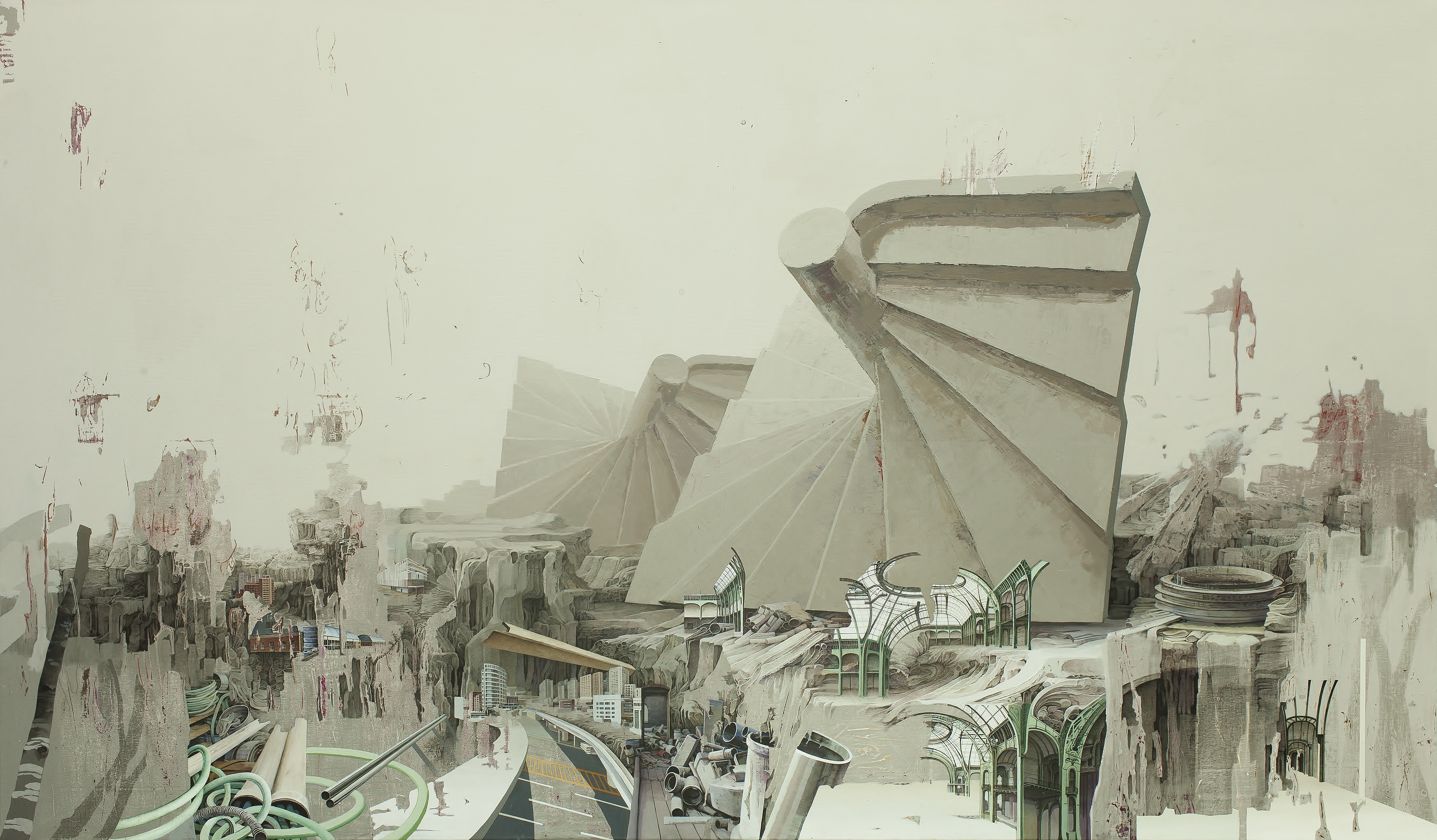JUNG–YEON – MARIA LUND
In 2006, Pluto was excluded from the solar system and was downgraded to the status of “dwarf planet” because of its mass and its volume, both too little, and a “deviant” trajectory. The first images of Pluto sent by the New Horizons probe (2015) revealed a surface partly covered in methane and nitrogen ice, which, at one spot, was shaped like a heart. Min Jung-Yeon was inspired by the symbolism of this rejection of a small different planet with a heart of ice. Thus, Pluto’s letter explores the notion of reconciliation with loss, integration of what escapes our understanding, of other viewpoints and assessments. This desire for balance despite differences, for cohesion in spite of contrasts, finds its pictorial expression in the artist’s new works. A third dimension, that one of a denser and rougher matter, has recently appeared and dialogs with the extremely fine and precise strokes (that were) already present in her earlier works. The color is used sparingly in a palette where soft and light tones as well as Indian ink black dominate.
P l u t o ‘ s s t a t e m e n t
The compositions show landscapes, urban sprawls or isolated elements. Certain works are defined by a “full”, whereas in others a single pictorial element comes to break the reigning ”emptiness”. Construction and deconstruction entangle themselves, intersect ,coexist, just like human creation and nature, alternately dominating each other. Fluxes and movements meet calm and isolation, images of our reality, those of a vaporous and dreamlike world and the subtle memory of tragic recent history mingles with visions of great poetry. In 1980, the year Min Jung-Yeon was born, her native area in the rural region of Gwangju, South Korea, was the scene of a massacre- where a a rebellion in the academic world was violently hushed by oppressive forces. The political reality of a still young democracy is often depicted in her work. Here through the presence of sheep, peacefully grazing grass, on one side of a wall blocking their view and obstructing their access to information (Mensonge/Lie). In 2017, her installation Blanc comme une héron (White as a heron) - a large immaculate white sculpture made of feathers placed in the center of a mirror – recalled the innocence claimed by President Park, impeached since then. Hibernation is the title of a drawing of a rough “diamond”, a geological fragment with multiple strata,engulfing a horizontally growing tree. The point of the diamond is slightly bluebut its triangular shadow is deep green. Thus, the exterior appreciation of a subject differentiates itself from the interior identity of the subject itself. The question of perception and its limitations is also raised in Souvenir de l’ombre (Memory of the shadow) that presents, on its left side, a mountain landscape wrapped in a blue fog, against a wall, which luminous back carries the shadows of several trees. Hence the wall marks the interface between two worlds, one dark and the other sunny.
o r g a n i c - g e o m e t r i c
If representing the organic and the geometric has often been the metaphor forthe feminine in opposition to the masculine, for their struggle or on the contrary for their fusion, the juxtaposition of natural elements (trees, strata, mountains…) with fragments of construction (roads, walls, staircases…) seems to have taken a more civilizational dimension in Min Jung-Yeon’s newest works. The organic has little room, is having a hard time or is isolated by a continuous movement as in the drawing of a rotating road. Time moves forward, crushes, replaces, absorbs; it is represented by strata that can be seen inside colossal constructions. In some artworks time seems frozen; we are in the realm of dream and the beauty of a mountain, of a rock or of fog enveloping them; the earth and sky are one, nature becomes a refuge and traditional Korean painting is echoed.
Pluto’s heart is softened, worried because of what he sees of the human planet.
b a c k g r o u n d
Born in 1979 in South Korea, Min Jung-Yeon graduated in Fine Arts (Hongik University, Seoul, 2003 and the Academy of Fine Arts in Paris (ENSBA), 2005). Showing regularly in Asian and European galleries since 2004, the artist has been collaborating with the Galerie Maria Lund since 2010. The gallery hosted two solo exhibitions of her work, Mémoire de la serre (Memories from a greenhouse, 2012) and Hier je comprenais mieux aujourd’hui (Yesterday I understood today better, 2015) and has shown her work in fairs and group exhibitions (Drawing Now, Paris, 2010-2013, – YIA, Paris 2014-2015 – Art15, London, 2015 – Art Paris, 2016 – ASIA NOW, Paris 2017). Min Jung-Yeon was the winner of the third edition of the Partners’ Prize held by the Musée d’art moderne et contemporain de Saint-Etienne Métropole and was rewarded with with a solo show of her drawings at the museum in 2012 Demander le chemin à mes chaussures (Asking my shoes for the way), along with the publication of a catalog. Several of her drawings are now part of the museum’s collections.
She also participated in Medi(t)ation, the third Asian Contemporary Art Biennial presented in the Taiwan National Museum of Fine Arts in 2011. In celebration of the Korean Year in France, her work was presented in the figurative section of the Seoul-Paris-Seoul exhibition curated by the Musée Cernuschi in Paris. In spring 2017, The State Museum of Oriental Art in Moscou welcomed her exhibition The Memory of Space.
Min Jung-Yeon’s work has been the subject of a dozen catalogs and numerous publications in the media in both Europe and Korea. Hibernation, a monograph, was published in 2009.
